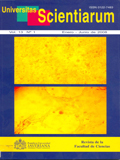Abstract
Durante los meses de julio a septiembre de 2003, se realizó la caracterización de la entomofauna de importancia forense presente en la descomposición de dos cerdos (Sus scrofa), utilizados como sujeto de muestreo y control respectivamente, en la granja experimental de la Federación Nacional de Cafeteros de Colombia (sede Consacá, Nariño). Los primeros insectos colonizadores del cadáver fueron las familias Calliphoridae y Sarcophagidae (Diptera); de la primera se capturaron individuos pertenecientes a Chrysomya albiceps (Wiedemann 1819), Chrysomya rufifacies (Macquart 1843), Chrysomya putoria (Wiedemann 1818) y Lucilia sp. siendo C. albiceps y Lucilia sp. las más abundantes durante el muestreo. Además de Diptera se presentaron algunas familias del orden Coleoptera, de los cuales los más importantes fueron: Histeridae, Staphilinidae, Silphidae, como depredadores, y Dermestidae como necrófago. Los otros grupos de insectos fueron observados ocasionalmente. Sin embargo, Labidus sp. subfamilia Ecitoninae (Formicidae), que se comportó como depredador de larvas de Diptera, estuvo presente durante todo el proceso de descomposición.
Palabras clave: Calliphoridae, Coleoptera, diptera, entomofauna, necrófago, Sarcophagidae.
Abstract
During July to September of 2003, characterization of entomofauna attracted by decomposition of two pigs (Sus scrofa) was carried out in the experimental farm of Federación Nacional de Cafeteros de Colombia at Consacá (Nariño). One of the two pigs was used as a control sample. Pioneer settler insects of carcass belonged to families Calliphoridae and Sarcophagidae (Diptera). From Calliphoridae individuals from Chrysomya albiceps (Wiedemann 1819), Chrysomya putoria (Wiedemann 1818), Chrysomya rufifacies (Macquart 1843) and Lucilia sp. were captured. C. albiceps and Lucilia sp. were the most abundant species. Families from Coleoptera order were also found: Histeridae, Staphilinidae, Silphidae, as predators, and Dermestidae as necrophagous. Other groups of insects were observed occasionaly. Nevertheless, as predators of Diptera grubs, individuals of Labidus sp. (Formicidae: subfamily Ecitoninae) were present during the entire decomposition process.
Key words: Calliphoridae, Coleoptera, diptera, entomofauna, Necrophagous, Sarcophagidae.
Univ. Sci. is registered under a Creative Commons Attribution 4.0 International Public License. Thus, this work may be reproduced, distributed, and publicly shared in digital format, as long as the names of the authors and Pontificia Universidad Javeriana are acknowledged. Others are allowed to quote, adapt, transform, auto-archive, republish, and create based on this material, for any purpose (even commercial ones), provided the authorship is duly acknowledged, a link to the original work is provided, and it is specified if changes have been made. Pontificia Universidad Javeriana does not hold the rights of published works and the authors are solely responsible for the contents of their works; they keep the moral, intellectual, privacy, and publicity rights. Approving the intervention of the work (review, copy-editing, translation, layout) and the following outreach, are granted through an use license and not through an assignment of rights. This means the journal and Pontificia Universidad Javeriana cannot be held responsible for any ethical malpractice by the authors. As a consequence of the protection granted by the use license, the journal is not required to publish recantations or modify information already published, unless the errata stems from the editorial management process. Publishing contents in this journal does not generate royalties for contributors.



